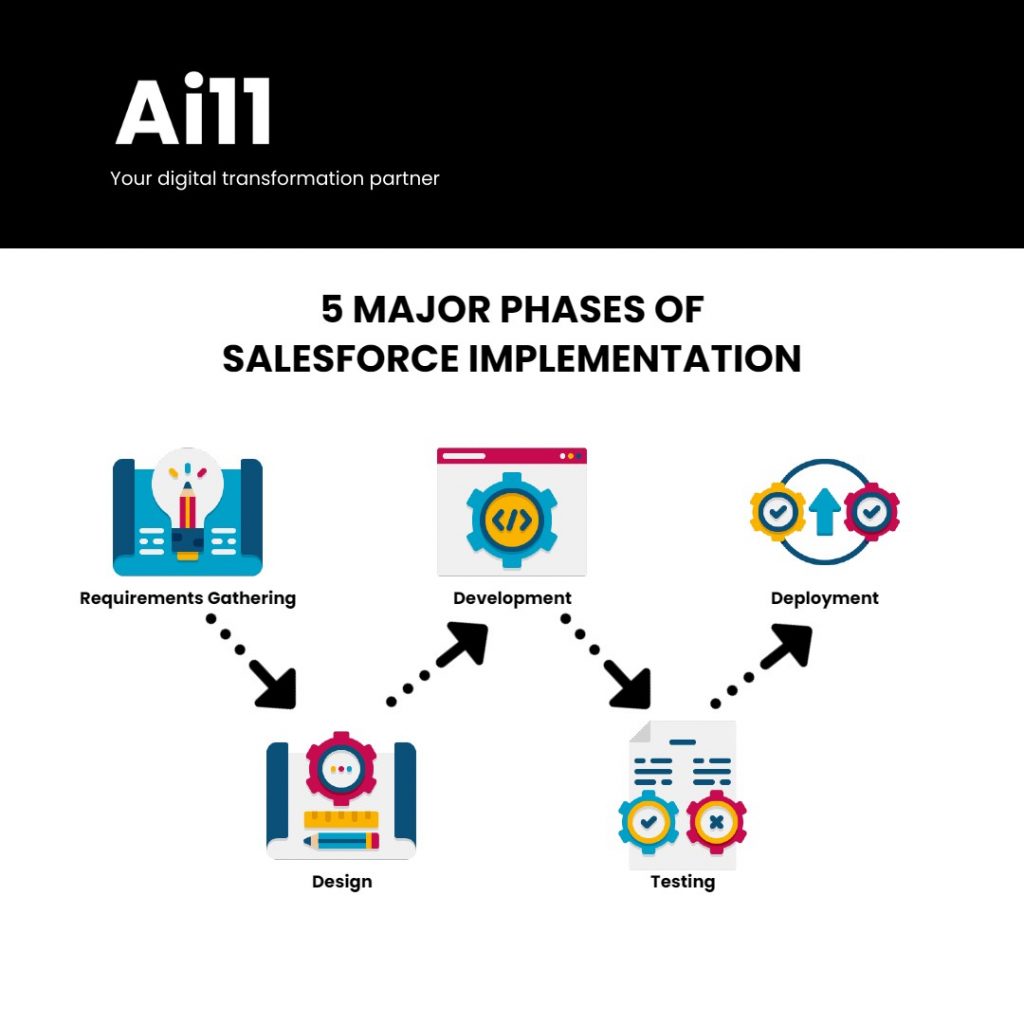
Introduction to Salesforce implementation
Salesforce implementation is a critical process for businesses looking to leverage the power of the Salesforce platform to enhance their business. It involves the deployment of Salesforce platform and its customization to meet the specific needs and goals of an organization. This comprehensive guide will walk you through the key steps involved in the Salesforce implementation process, from preparation to go-live and post-implementation support.
Understanding the Salesforce implementation process
Before diving into the implementation process, it is essential to gain a clear understanding of what it entails. Salesforce implementation involves several stages, including requirement, design, development, testing, deploymentphase. Each stage is crucial for ensuring a successful implementation and the seamless integration of Salesforce into your organization’s workflows.
Key steps in the Salesforce implementation process
1. Preparing for a successful Salesforce implementation
Proper preparation is the foundation of a successful Salesforce implementation. Start by defining your goals and objectives for using Salesforce. Identify the key stakeholders and involve them in the planning process. Conduct a thorough analysis of your existing systems and processes to determine how Salesforce can optimize and streamline your operations. Create a detailed project plan, including timelines, milestones, and resource allocation.
2. Selecting the right Salesforce implementation partner
Choosing the right Salesforce implementation partner is crucial for a successful implementation. Look for a partner with a proven track record and expertise in your industry. Consider their experience, certifications, and client testimonials. Evaluate their ability to understand your unique business requirements and customize Salesforce accordingly. A good implementation partner will guide you through the process, provide training and support, and ensure a smooth transition to Salesforce.
3. Customizing Salesforce to meet your business needs
One of the key advantages of Salesforce is its flexibility and ability to adapt to different business requirements. During the customization phase, work closely with your implementation partner to configure Salesforce to match your specific workflows and processes. This may involve creating custom objects, fields, and page layouts, setting up automation rules, and defining security settings. Aim to strike a balance between simplicity and functionality to ensure user adoption and maximize the benefits of Salesforce.
Migrating data to Salesforce
Migrating data from your legacy systems to Salesforce is a critical step in the implementation process. Start by conducting a thorough data audit to identify the types of data you need to migrate and ensure its accuracy and completeness. Create a data migration plan, including data mapping, cleansing, and validation steps. Use Salesforce’s data import tools or consider third-party solutions for complex data migrations. Test the migrated data to ensure its integrity and consistency within Salesforce.
Training and onboarding for Salesforce users
Proper training and onboarding are essential for ensuring the successful adoption of Salesforce by your users. Develop a comprehensive training plan that covers the various aspects of Salesforce, including navigation, data entry, reporting, and dashboards. Provide both classroom and online training options to cater to different learning styles. Consider creating user guides, video tutorials, and knowledge base articles to serve as ongoing resources for your users. Encourage feedback and continuous learning to foster a culture of Salesforce proficiency within your organization.
Testing and quality assurance in Salesforce implementation
Thorough testing and quality assurance are vital to identify and resolve any issues or bugs before the go-live phase. Develop a testing plan that covers both functional and user acceptance testing. Test all the customizations, workflows, and integrations within Salesforce to ensure they work as intended. Involve end-users in the testing process to gather feedback and validate the system’s usability. Document and address any issues or bugs promptly to avoid complications during the go-live phase.
Go-live and post-implementation support
The go-live phase marks the official launch of Salesforce within your organization. Ensure all users are prepared and confident in using Salesforce by providing additional support and resources during this transition period. Monitor the system closely to identify any issues or performance bottlenecks and address them promptly. Provide ongoing training, support, and regular system updates to keep your users engaged and maximize the benefits of Salesforce.
Common challenges in Salesforce implementation and how to overcome them
Despite careful planning and execution, Salesforce implementations can face various challenges. Some common challenges include resistance to change, data quality issues, integration complexities, and user adoption struggles. To overcome these challenges, it is crucial to have a robust change management strategy in place, ensure data cleansing and validation processes, collaborate with IT teams for seamless integrations, and provide comprehensive training and support to users.
Best practices for a successful Salesforce implementation
To ensure a successful Salesforce implementation, follow these best practices:
- Define clear goals and objectives for Salesforce usage.
- Involve key stakeholders in the planning and decision-making process.
- Choose an experienced Salesforce implementation partner.
- Customize Salesforce to match your unique business requirements.
- Conduct a thorough data audit and plan for data migration.
- Develop a comprehensive training plan and provide ongoing support.
- Test extensively before the go-live phase.
- Monitor performance and address issues promptly.
- Foster a culture of continuous learning and improvement.
Conclusion
Salesforce implementation can be a complex process, but with proper planning, the right partner, and a focus on best practices, it can lead to significant improvements in your organization’s efficiency and productivity. By understanding the key steps involved in the Salesforce implementation process and addressing common challenges, you can ensure a successful implementation and maximize the benefits of Salesforce for your business.

